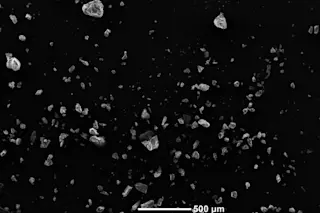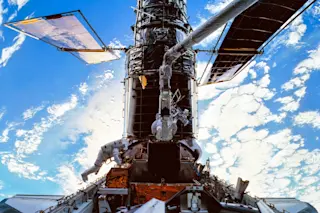This summer's Russian module launch marked a critical milestone toward a permanent human presence on the International Space Station, but many space buffs would rather see expedited plans for more ambitious and distant missions piloted by people. Recent discoveries indicating subterranean water on Mars and oceans below Europa's ice sheets have renewed calls from the Planetary Society and other advocacy groups to reinstate a goal lost after the last Apollo moon landing in 1972: human exploration beyond Earth orbit.
But NASA seems devoted to robotic probes, which circumvent the difficulties of supporting human life far from terra firma. Space, flight surgeons emphasize, is not exactly a safe place.
Choosing between robots and people is not easy, but with decades of experience behind us, we can at least assemble a list of the hazards humans face off Earth. (Sometimes we can even attach statistics to the dangers. There have been 551 astronaut flights on the shuttle and seven deaths, a one-in-79 chance of not making it.)
Some of this risk assessment comes from learning by doing: We have definitively measured the irreversible bone loss suffered by long-term orbiting astronauts, for example. Other insight comes from reviewing our humbling inability to predict mechanical failures like the abrupt decompression that killed three Soyuz 11 cosmonauts in 1971.
So far, one fact stands out from the rest— all risks increase as we venture farther from Earth. Just above our atmosphere, at orbiting altitude, separation between atmospheric atoms causes all kinds of havoc. Breathing, of course, becomes impossible, and the thin atmosphere allows high levels of radiation to zing about, not to mention lowering the temperature to 250 degrees below zero.
Farther out, the blast of subatomic particles from the sun would blow through an unprotected astronaut at a million miles per hour. And every 11 years or so, during a cycle of increased solar activity, fierce coronal ejections would hurl lethally dense bursts of atomic debris— at twice their normal speed— toward adventurers.
The moon, the first obvious stop, offers little sanctuary. There, a dozen moon-walking astronauts stood on ground that sizzled at temperatures near the boiling point of water and faced solar radiation more intense than that found in Earth orbit.
Mars isn't much better. The Red Planet's atmosphere offers little oxygen and is so thin at the surface that its pressure is equal to ours at 33,000 feet, the cruising altitude of commercial jets.Beyond Mars, the news is less gloomy than once believed. Before the Pioneer and Voyager missions, scientists thought that astronauts had less chance of getting through the asteroid belt between Mars and Jupiter than of reaching the tenth stage of Asteroids, the video game. Happily, our robotic probes indicate that the belt's debris is widely spaced.
Once safely through, however, the game gets far tougher. Jupiter's environment becomes lethal long before a spaceship could get close. The gas giant's huge, powerful magnetic field envelops all its moons and sucks loose one ton of material per second from nearby satellite Io alone. The intriguing moon Europa may beckon with possibilities, but as in a Greek myth, it is guarded by fearsome gods. Jupiter's speedy rotation, metallic core, and huge mass create an awesome charged-particle environment that traps and maintains intense radiation.
Beyond Saturn, Uranus and Neptune and Pluto are billions of miles away. The logistics of supporting humans within a rocket for decades on end to travel that far boggle the mind. Indeed, the vulnerability of human life in space may be best measured by the fact that, despite extraordinary precautions, more than a dozen astronauts have died within just a few miles of Earth.

For more about planetary exploration, see nssdc.gsfc.nasa.gov/planetary/chronology.html














